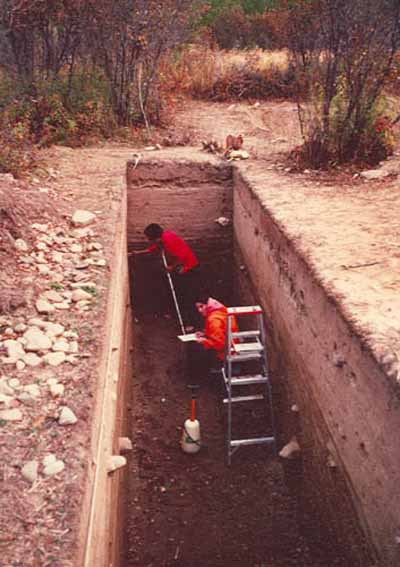Oxbow National Historic Site of Canada
Red Bank Indian Reserve (Metepenagiag), New Brunswick

Archaeological dig
(© Parks Canada Agency/Agence Parcs Canada, ca./vers 1982.)
Address :
Red Bank Indian Reserve (Metepenagiag), New Brunswick
Recognition Statute:
Historic Sites and Monuments Act (R.S.C., 1985, c. H-4)
Designation Date:
1982-06-12
Event, Person, Organization:
-
Mi’kmaq people
(People, group)
Other Name(s):
-
Oxbow
(Designation Name)
-
Metepenagiag Heritage Park
(Other Name)
Research Report Number:
June 2001-11, 2007-043
Plaque(s)
Existing plaque: Red Bank Indian Reserve, New Brunswick
One of the largest pre-contact archaeological sites in the Maritimes, Oxbow is remarkable for its rich and deeply stratified record of almost continuous human occupation. For the past three millennia, Aboriginal people have repeatedly come to this oxbow in the Miramichi River to fish, hunt, and gather plants. Seasonal flooding covered their camps with silt, preserving evidence of the everyday life of the inhabitants, including stone tools, ceramics, and fire pits. This site is of lasting significance for the Metepenagiag Mi'kmaq Nation, whose ongoing responsibility as caretakers has ensured its continued existence.
Description of Historic Place
Oxbow National Historic Site of Canada is an archaeological site located within the reserve land of the Metepenagiag Mi’kmaq Nation, New Brunswick across the Little Southwest Miramichi River from the present Mi’kmaq community. The site is an oxbow bend of the river and follows the north bank of the river, encompassing the place where stratified archaeological resources are buried in the silts and gravels of the river bank to a depth of up to two metres. It is situated within the Metepenagiag Heritage Park, as the Augustine Mound National Historic Site of Canada.
Heritage Value
Oxbow was designated a national historic site of Canada in 1982 because it is a unique cultural record of a flourishing Mi’kmaq community which has endured for at least 3000 years and it shows a direct relationship between the everyday life of the community and its spiritual centre at the Augustine Mound.
The heritage value of Oxbow National Historic Site of Canada lies in its role as witness and record of 3000 years of continuous Mi’kmaq use of this site as illustrated by its setting, site, dense composition, by the spatial, functional and cultural inter-relationships of its layered components, and by the rich and varied nature of the archaeological evidence they contain. Value also lies in the direct association of early levels of the site with the Augustine Mound, designated national historic site of Canada in 1975.
Oxbow National Historic Site of Canada contains evidence of 3,000 years of Mi’kmaq history (from 1000 BC to the present) on the north bank of the Little southwest Miramichi River at the head of tide. Annual flooding of the river bank has created a well-stratified site in which the cultural development through time is preserved in multiple layers of sediment. This deep stratigraphic development is virtually unique in Maritime Canada. Most of the archeological remains constitute a collection held in the archaeological services office of the New Brunswick Government in Fredericton.
Sources: Historic Sites and Monuments Board of Canada, Minutes, June 2000; Augustine Mound and Oxbow National Historic Sites of Canada Commemorative Integrity Statement, 2004.
Character-Defining Elements
Key elements of this site contributing to its heritage value include: its location and setting at an oxbow bend of the Little Southwest Miramichi River; the integrity of the stratification of the site; the continued relationship of artifacts removed from the deposits to the site; the spatial relationship of this site to the Augustine Mound; the material, functional, cultural and temporal inter-relationship between artifacts found on lower layers of the Oxbow sites and those at the Augustine Mound; viewscapes from the oxbow shore up and down the Little Southwest Miramichi River; the unique, continuous and clear record of cultural development exhibited in the artifact collection; its relationship to and continuity with the modern community and population of Metepenagiag Mi’kmaq Nation the integrity of the natural environment, chiefly of the fauna.